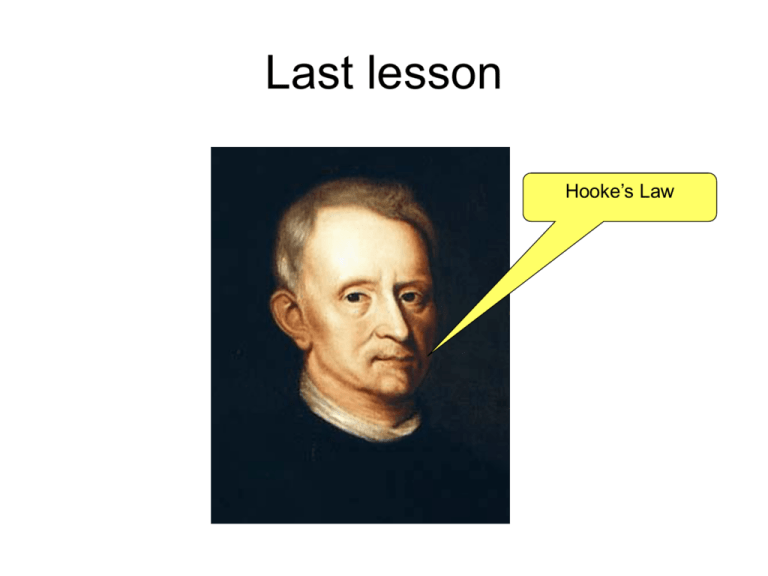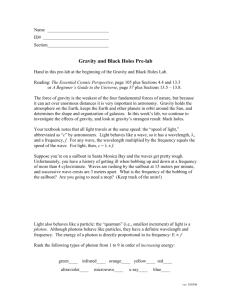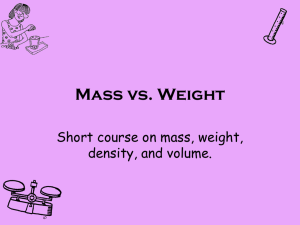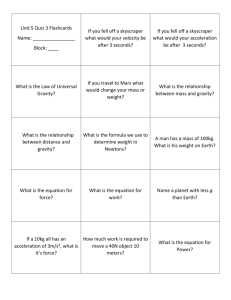Moments – Turning forces
advertisement

Last lesson Hooke’s Law Investigating forces and springs You are going to investigate how much a spring stretches when a force is applied to it. The amount a spring stretches is called its extension. This is the difference in length between the stretched spring and the length of the spring when it was unstretched. (Remember we are looking at the force on the spring. A mass of 100g will have a weight (force of gravity pulling it down) of 1 Newton. • • • • Add masses to your spring and carefully measure its extension. You can do this until the spring breaks! (but you must wear goggles and be careful during this investigation). Your experimental report will include the following A table of results A graph of your results A conclusion describing what you have discovered (think about this!) Table of results Force (N) 0 Length of spring Extension (cm) (cm) 3.4 0 1 5.4 2 2 7.4 4 3 9.4 6 Graph Force (N) Complete investigation for Weds 21st October 1. Table of results 2. Graph 3. Two sentences of conclusion Extension (cm) Hooke’s law Elastic limit Force (N) The extension of a spring is proportional to the force applied (until the elastic limit is reached) Extension (cm) Steel, glass and wood Force Even though they don’t stretch much, they obey Hooke’s law for the first part of the graph Extention Rubber Force Extension Homework • Set Friday 23rd October. Due Wednesday 3rd November. • Complete Physics for IGCSE page 61 Questions 1 to 4 Today’s lesson • Orbital motion and satellites Satellites How far could you kick a dog? From a table, medium kick. How far can you kick a dog? Gravity Harder kick? Harder kick Gravity Small cannon? Woof! (help) Small cannon Woof! (help) Gravity Bigger cannon? Bigger cannon Gravity Gravity Even bigger cannon? Even bigger cannon Gravity Gravity Gravity VERY big cannon? VERY big cannon Gravity Humungous cannon? Dog in orbit! The dog is now in orbit! (assuming no air resistance of course) Dog in orbit! The dog is falling towards the earth, but never gets there! Dogs in orbit! Gravity The force that keeps an object moving in a circle is called the centripetal force (here provided by gravity) Other examples Earth’s gravitational attraction on moon Uniform circular motion The centripetal acceleration/force is always directed towards the centre of the circle Centripetal force/acceleration velocity Note! • There is no such thing as centrifugal force! (at least not until you get to university!) CENTRIFUGAL Types of orbits Geostationary The satellite orbits once every 24 hours, so appears to stay above the same point on the earth’s surface Looking from above the North pole Geostationary Useful for communications satellites. Also for weather over one area. Polar Satellite orbits over the poles Polar Useful for mapping and remote sensing when the whole of the earth’s surface needs to be studied Some famous satellites Sputnik th (4 October 1957) Sputnik • • • • • • th (4 October 1957) Russian 84 kg, 58cm diameter 800km above the earth 30 000km/h Orbited every 90 mins Fell after 92 days Sputnik 2 (a month later) Sputnik 2 (a month later) • 450 kg • Carried a dog! (Laika) • Laika is believed to have died from overheating in the cabin a few hours after launch It’s a dogs life. Hubble Space telescope Hubble Space telescope • Launched in 1990 • 13.1m long • Doesn’t have to see through the earth’s atmosphere That’s it! Can you try some questions now? Page 48 and 49 in your book. Questions 1 to 5







